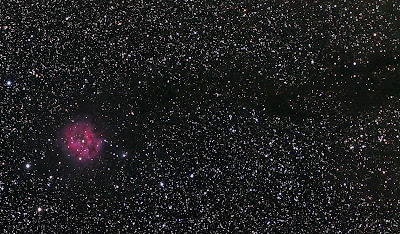
The Cocoon Nebula is a glowing cloud of mostly hydrogen gas, illuminated to flourescence by the hot, blue stars that are forming from the raw materials of the cloud. This particular object lies at the end of a long, thin dark nebula - you can see it silhouetted against the background of more distant stars, but is not lit up directly. I've never seen this object directly through a telescope, though the long, linear dark nebula can be spotted in binoculars against the clouds of Milky Way stars...
Taking these sorts of images seems to have dominated my astronomical interests the last few years, and it seems strange to be away from it for so long - though only whle I'm in Illinois - too much light pollution and hassles to pursue it here. In addition, I didn't really bring any of the equipment up from Arizona... Anyway, most of these objects are very faint, but obviously very photogenic, so to properly record them, you need to take long exposures, then combine many exposures to reduce the electronic noise that the individual exposures contain. On a long night, you might be able to do only a few objects with good results. I have pretty basic equipment (no computerized go-to), so first I need to find the faint fellow and align the camera how I want it, find a guide star (my mount doesn't track well enough for exposures thru a telescope longer than 30 seconds or so), then set up the camera for a sequence of exposures. Once you start the exposures, then you can relax and do some binocular or other observing - as long as the autoguider keeps the guide star centered. All this is after typically driving an hour or more, and spending about that length of time setting up the gear. So it really is a lot of work to do all this, but it is also quite rewarding capturing some of the amazing spectacles of the night sky. Keep an eye out - there will be a lot more in the fall and winter when we get back to Arizona!














1 comment:
Very nice image! The Cocoon is one I have yet to try.
Nights under a dark sky spent fiddling with gear for many hours to produce just a couple photographs. Focus, find the target, find a guide star, take a few frames, check the focus again, take a few more frames, take some calibration frames, etc...
Then a few more hours processing the results.
At least these days I can do it in the driveway without driving for hours to get to dark skies.
Looking forward to seeing more of your efforts!
Post a Comment